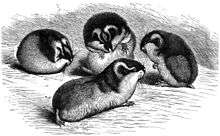Norway lemming
The Norway lemming, also Norwegian lemming (Lemmus lemmus) is a common species of lemming found in northern Fennoscandia. It is the only vertebrate species endemic to the region. The Norway lemming dwells in tundra and fells, and prefers to live near water. Adults feed primarily on sedges, grasses and moss. They are active at both day and night, alternating naps with periods of activity.
| Norway lemming | |
|---|---|
 | |
| Scientific classification | |
| Kingdom: | Animalia |
| Phylum: | Chordata |
| Class: | Mammalia |
| Order: | Rodentia |
| Family: | Cricetidae |
| Subfamily: | Arvicolinae |
| Genus: | Lemmus |
| Species: | L. lemmus |
| Binomial name | |
| Lemmus lemmus | |
 | |
| Norway lemming range[2] | |
| Synonyms | |
|
Mus lemmus Linnaeus, 1758 | |
Description
The Norway lemming has a bold pattern of black and yellow-brown, which is variable between individuals. It grows to a size of 155 mm. The tail is very short (10 – 19 mm). It weighs up to 130 g. The dental formula is 1/1, 0/0, 3/3.[3]
Behavior
The Norway lemming has a dramatic three- to four-year population cycle, in which the species' population periodically rises to unsustainable levels, leading to high mortality, which causes the population to crash again.
The Norway lemming spends the winter in nests under the snow. When the spring thaws begin and the snow starts to collapse, they must migrate to higher ground, where the snow is still firm enough for safety, or, more commonly, to lower ground, where they spend the summer months. In autumn, they must time their movement back to sheltered higher ground carefully, leaving after alpine snow cover is available for their burrows and nests, and before the lowlands are made uninhabitable by frost and ice.
When the seasons are particularly good (short winters without unexpected thaws or freezes, and long summers), the Norway lemming population can increase exponentially: they reach sexual maturity less than a month after birth, and breed year-round if conditions are right, producing a litter of six to eight young every three to four weeks. Being solitary creatures by nature, the stronger lemmings drive the weaker and younger ones off long before a food shortage occurs. The young lemmings disperse in random directions looking for vacant territory. Where geographical features constrain their movements and channel them into a relatively narrow corridor, large numbers can build up, leading to social friction, distress, and eventually a mass panic can follow, where they flee in all directions. Lemmings do migrate, and in vast numbers sometimes, but noion of a deliberate march into the sea is false.
According to genetic research,[4] the Norwegian lemming survived the Pleistocene glaciation in western Europe, inhabiting various refugia which were not covered by ice. Alternatively, some researchers have contended the Norwegian lemming populations had arisen from ancestors of the present-day brown lemming (Lemmus sibiricus), moving in after glaciers receded.
When confronted with a predator, Norway lemmings do not try to run away, attacking the predator or intruder, instead. They have also been known to attack approaching humans. With their colorful body and brave behavior, it has been suggested that they belong to aposematic species [5]
Gallery
 In snow
In snow Skull
Skull Illustration from Brehms Tierleben
Illustration from Brehms Tierleben
References
- Henttonen, H. (2008). "Lemmus lemmus". IUCN Red List of Threatened Species. 2008. Retrieved 5 June 2009.CS1 maint: ref=harv (link) Database entry includes a brief justification of why this species is of least concern.
- IUCN (International Union for Conservation of Nature) 2008. Lemmus lemmus. In: IUCN 2014. The IUCN Red List of Threatened Species. Version 2014.3. http://www.iucnredlist.org. Downloaded on 22 March 2015.
- MacDonald, David; Priscilla Barret (1993). Mammals of Britain & Europe. 1. London: HarperCollins. pp. 241–242. ISBN 0-00-219779-0.
- Fedorov, V.B. & Nils Christian Stenseth (2001). Glacial survival of the Norwegian lemming (Lemmus lemmus) in Scandinavia: inference from mitochondrial DNA variation. Proceedings of the Royal Society: Biological Sciences, 268(1469):809-814.
- Anderson, Malte. 1976. “Lemmus lemmus: A possible case of aposematic colouration and behaviour” Journal of Mammalogy 57, 3, Aug., 461-469
External links
- Tundra Animals species profile
- Boreal Forest species profile
- Nature in Finland-ex Virtual Finland-2007-archived in Wayback Machine.
- America Zoo species profile
- "The lemming cycle" (PDF). (92.6 KiB) article by Nils Christian Stenseth on the regular population cycles seen in lemmings and other northern rodents
